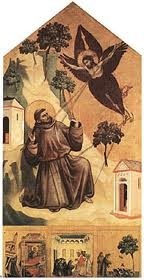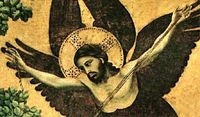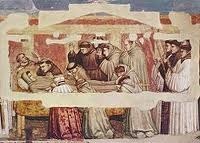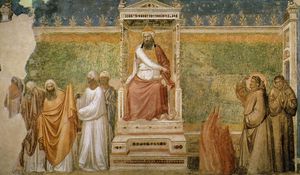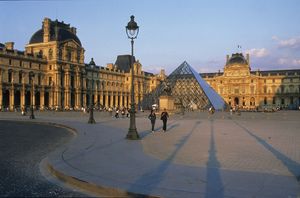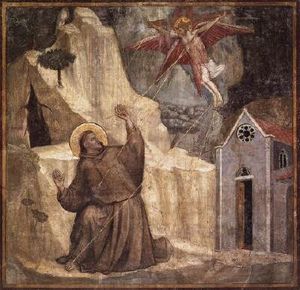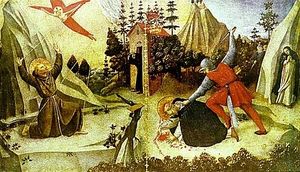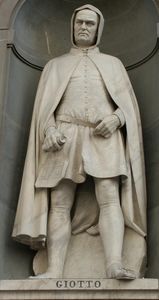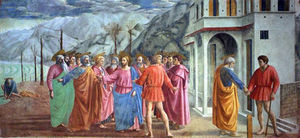Stigmatization of St. Francis (Louvre)
- Date of Creation:
- 1300
- Height (cm):
- 314.00
- Length (cm):
- 162.00
- Medium:
- Tempera
- Support:
- Wood
- Subject:
- Figure
- Framed:
- No
- Art Movement:
- Renaissance
- Created by:
- Current Location:
- Paris, France
- Stigmatization of St. Francis (Louvre) Page's Content
- Story / Theme
- Inspirations for the Work
- Analysis
- Critical Reception
- Related Paintings
- Artist
- Art Period
- Bibliography
Stigmatization of St. Francis (Louvre) Story / Theme
Stigmatization of St. Francis was painted in the first year of the fourteenth century for the Church of San Francesco in Pisa. Di Bondone, who quietly supported the Franciscan church throughout his life, drew inspiration from St. Francis's love of nature and keen observation of the world around him.
With his strikingly realistic figures and meticulous use of placement, color and gesticulation, di Bondone admirably recreated the scene in which St. Francis receives the stigmata from Christ.
Legend says that St. Francis, during a forty-day period of fasting and praying in the Apennines with his disciples, experienced a vision one morning as the sun was rising. He saw Christ in the form of a six-winged angel in the sky above, and fell to his knees in awe and fear, raising his hands in a gesture of surrender. When the vision ended, he felt sharp pains and discovered he had been given the stigmata (wounds in the hands and feet that the crucified Christ received).
Stigmatization of St. Francis (Louvre) Inspirations for the Work
Although choosing sides was undoubtedly potentially bad for business, di Bondone throughout his life and career supported the Franciscans and painted numerous frescoes depicting the heroism and saintliness of St. Francis. Di Bondone's first known work were some of the frescoes at the Church of St. Francis in Assisi, assisting his master, Cimabue.
Due to the popularity of Roman Catholicism during the Middle Ages, the overwhelming majority of the art produced at the time was inspired by religious events and individuals. The church, moreover, relied heavily on emotional art to intensify devotion (and encourage financial support), keeping artists like di Bondone constantly in demand.
By the time he painted Stigmatization of St. Francis in 1300, di Bondone had risen to fame on his own and begun to draw attention from the religious and artistic communities for his wholly unique ability to paint his subjects so realistically and so full of emotion.
He was inspired primarily by his admiration for the Franciscans and their emphasis on compassion for others and love of nature. His recreation of St. Francis' stigmatization is fraught with intense feeling and detailed in a revolutionary new way that helped his fame grow in leaps and bounds.
Stigmatization of St. Francis (Louvre) Analysis
Although Stigmatization of St. Francis is one of di Bondone's earlier works, it demonstrates the same attention to detail, reality and emotion that characterizes his later pieces and even his masterpiece, the Scrovegni Chapel in Padua.
Composition:
Stigmatization of St. Francis is just one work on the long list of di Bondone's works famous for their carefully devised composition. Working with a flat surface and limited space, di Bondone uses the scene's background - primarily the mountains - to both narrow the scope of the action and define the overall space.
The scene is particularly unique for its innovative juxtaposition of the earthly and divine; the heavenly winged Christ is suspended above typical geographic features, including St. Francis' modest dwelling.
Color palette:
Di Bondone uses mainly earth tones in this scene, perhaps to communicate a sense of earthy reality despite the supernatural appearance of Christ. St. Francis' robe, for example, is a dull brown, subtly indicating his humble, simple existence. The trees, on the other hand, are a lush green. Later in his career, di Bondone would replace the traditional gold background of religious art with blue skies, ominous clouds, and the like.
Use of light:
The obvious light source in Stigmatization of St. Francis is Christ himself; the brilliant, holy light casts an ethereal shine on all it touches, leaving the rest in shadow. The rocks behind St. Francis and the sides of the mountain are darkened, illuminating a downward-sloping vertical line that 'points' to St. Francis.
Tone:
The tone of Stigmatization of St. Francis is overwhelmingly reverent. The holy light emanating from Christ falls on the stunned, awestruck face of St. Francis, kneeling and with arms raised in an expression of total surrender. Di Bondone intended to communicate the intense emotion that St. Francis must have been feeling: a combination of wonder, fear, surprise and even calmness as he locks eyes with Christ in total acceptance of what is happening.
Stigmatization of St. Francis (Louvre) Critical Reception
Stigmatization of St. Francis is generally considered evidence of di Bondone's early successes in creating a three-dimensional effect on a flat surface, incorporating the stylistic elements of naturalism for which he became so famous.
Completed in 1300, the panel was most likely housed in the Church of San Francesco until it was purchased during the twentieth century by the Louvre in Paris, where it remains today. Situated alongside some of the Italian Renaissance's best-known and most-loved works, the esteem in which di Bondone's work is held is as high now as it was when he painted it over seven hundred years ago.
Stigmatization of St. Francis (Louvre) Related Paintings
Stigmatization of St. Francis (Louvre) Artist
Giotto di Bondone established his career during the late Middle Ages. The son of a peasant family and apprenticed to Italian master Cimabue at a rather young age, he flourished professionally and very soon became famous and well-known in his own right.
Di Bondone is best-known for his strictly realistic portrayal of all things. He believed in representational painting and sought to reproduce as accurately as possible not only mountains and trees but also facial expressions, gestures and even posture, helping the artistic community move away from the stale and highly stylized Byzantine tradition.
Little is known about di Bondone's personal life, and the authorship of several of his important works remains disputed due to an absence of records. It is likely that, despite his immense importance to the inception of the Renaissance, his life and works have been overshadowed by massively popular artists that followed such as Michelangelo, Donatello and Raphael.
Stigmatization of St. Francis (Louvre) Art Period
The period in which di Bondone worked is characterized by an overlapping of art movements. Some scholars classify di Bondone as simply a progressive Medievalist, while others believe he was influenced exclusively by Gothicism. This ambiguity is probably indicative of his overall undeniable uniqueness.
What is certain, however, is that the next definitive step in the art world was not taken until the middle of the fifteenth century, when the beginning of the Renaissance sprang from the brush of Italian master Masaccio.
Stigmatization of St. Francis (Louvre) Bibliography
To learn more about Giotto and his artworks please choose from the following recommended sources.
• Derbes, A. & Sandona, M. The Cambridge Companion to Giotto. Cambridge University Press, 2004
• Eimerl, Sarel. The World of Giotto, C. 1267 - 1337. Little Brown & Company, 1967
• Norbert, Wolf. Giotto di Bondone. Taschen, 2000
• Richardson, Carol M. , et al. Renaissance Art Reconsidered: An Anthology of Primary Sources Wiley-Blackwell, 2006
• Paolettii, John T. & Radke, Gary M. Art in Renaissance Italy. Laurence King, 2005
• Nichols, Tom. Renaissance Art: A Beginner's Guide. Oneworld Publications, 2010
• Hartt, Frederick & Wilkins, David. History of Italian Renaissance Art. Pearson Education, 2010

